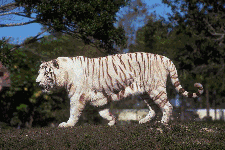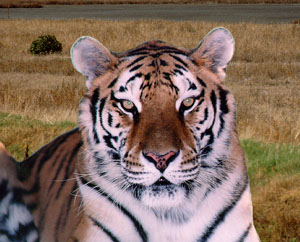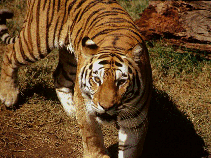Save the Tigers!!!

Please, before time runs out!!!
![]()
Save the Tigers!!!

Please, before time runs out!!!
![]()


There was once 8 subspecies of tiger in the wild. Today there are only 5 subspecies remaining. Our best estimates suggest that there are between 5,000 to 7,000 wild tigers remaining today. There are about 1,200 zoo tigers as well. That is as large as the numbers go for the remaining 5 subspecies of the largest cat in the world. Considering a tiger is poached everyday in India doesn't give much hope, does it? Scientists now estimate that by 2010 wild tigers will be extinct. Please don't stand idly by and watch these magnificent creatures perish...
Tigers have fascinated mankind for centuries. Two Indian epics, Mahabharata and Ramayana, dating back as far as 300 BC use the tiger as representations of beauty, power and ferocity. In Pakistan, the tiger, no longer found in this country, is scultped on seals of an ancient civilization which once thrived over 5,000 years ago. The ancient peoples of China once interpreted the markings on a tiger's forehead as meaning king. In Korea, "Land of the Blue Dragon and White Tiger," people believe a dragon guards the west while a tiger guards the east.

The table shows the tigers scientific and common name and the most recent estimates of their numbers:

| Scientific Name | Common Name | Remaining Tigers |
| Panthera tigris tigris | Bengal Tiger | 3,000 - 4,700 |
| Panthera tigris virgata | Caspian Tiger | Extinct by 1970s |
| Panthera tigris altaica | Siberian Tiger | 160 - 450 |
| Panthera tigris balica | Bali Tiger | Extinct in 1937 |
| Panthera tigris amoyensis | South China Tiger | 20 - 30 |
| Panthera tigris sondaica | Javan Tiger | Extinct in 1980s |
| Panthera tigris corbetti | Indo-Chinese Tiger | 1,100 - 1,800 |
| Panthera tigris sumatrae | Sumatran Tiger | 400 - 500 |
There are two main subspecies of the tiger remaining today - the Siberian tiger (Panthera tigris altaica) and the Bengal tiger (Panthera tigris tigris). The modern tiger originated somewhere in the northern part of Asia, most likely China, over 1 million years ago and has spread south ever since.
 The Siberian tiger is the rarer of the two subspecies with no more than 450 wild tigers. The Siberian tiger measures from 6.5 to 12 feet in length (that includes its tail!) and can weigh from 400 to 800 pounds! The Siberian tiger has thick yellow fur with dark stripes.
The Siberian tiger is the rarer of the two subspecies with no more than 450 wild tigers. The Siberian tiger measures from 6.5 to 12 feet in length (that includes its tail!) and can weigh from 400 to 800 pounds! The Siberian tiger has thick yellow fur with dark stripes.
Wild Siberian tigers are found in Russia and China today. In Russia the Siberian tiger is sometimes called the Amur tiger, Manchurian tiger and the Northeast China tiger. The World Conservation Union considers the status of the Siberian tiger to be Critical. They estimate that the tigers numbers fell to only 24 during the 1940s and have risen to possibly as many as 200 by the mid-1990s. By 1996, the Siberian Tiger Project said there are between 415-475 tigers. The Law of the Russian Federation on Environment Protection and Management of 1992 gave the Siberian tiger full legal protection from poaching. There are 3 protected areas for tigers in Russia's Far East - Kedrovaya Pad Reserves at 178 square kilometers, Lazovsky at 1,165 square kilometers, and Sikhote-Alin at 3,470 square kilometers. Its range extends as far north as the Artic Circle. In China, there are occasional sightings of the Siberian tiger near the North Korean border. The Cat Specialist Group estimates that there are fewer than 50 wild Siberian tigers in China. Because of such few numbers, the Chinese Siberian tiger will not last much longer. It is the wild Russian tiger that we must look to to repopulate the endangered Siberian tiger species.
The captive populations of the Siberian tigers are the largest for all of the tiger subspecies. In 1996, the International Tiger Studbook said there are 525 captive Siberian tigers in zoos. There are 182 in the United States and Canada, 223 in Europe, 82 in Japan and 40 in other Asian zoos. The captive population of Siberian tigers are all descended from 83 wild tigers and are thought to be a very stable and diverse population.
 The Bengal tiger grows to be only about 10 feet long (including the tail) and weighs in at around 400 to 600 pounds. The Bengal tiger has a richer color and darker stripes than the Siberian tiger. Bengal tigers occasionally have a coat that is white instead of orange. These white Bengal tigers have icy blue eyes and black or brown stripes. They are not albino tigers; if they were they would not have colored stripes or blue eyes - they would have pink eyes. Bengal tigers can be found in central and southern India, southern Nepal, Bhutan, western Myanmar and Bangladesh.
The Bengal tiger grows to be only about 10 feet long (including the tail) and weighs in at around 400 to 600 pounds. The Bengal tiger has a richer color and darker stripes than the Siberian tiger. Bengal tigers occasionally have a coat that is white instead of orange. These white Bengal tigers have icy blue eyes and black or brown stripes. They are not albino tigers; if they were they would not have colored stripes or blue eyes - they would have pink eyes. Bengal tigers can be found in central and southern India, southern Nepal, Bhutan, western Myanmar and Bangladesh.
The wild Bengal tiger is the largest in India. The World Conservation Union Cat Specialist Group estimates between 3,250 - 4,700 Bengal tigers. There are 66 different protected areas for the Bengal tiger in India. There are 3 protected areas for Bengal tigers in Nepal housing 150-250 tigers, 4 protected areas in Bhutan housing 50-250 tigers, 3 protected areas in Bangladesh housing 300-450 tigers. The number of wild Bengal tigers in Myanmar is unknown.
Bengal tigers have been captive in zoos since 1880. The first zoo in India to house tigers was the Alipore Zoo in Calcutta. They have been bred so successfully in captivity that there are too many today. Many are sent to sancturaries to live out their life. The International Tiger Studbook says the total captive population of pure-bred (there has been a lot of crossing of pure Bengals with tigers of unknown descent) Bengal tigers is 333. Of those 333, 289 have the orange color and the remaining 44 are white. All of the captive Bengal tigers are housed in zoos in India except for 1 female Bengal tiger that is housed in the United States.
 The Sumatran tiger is the smallest of the subspecies of tiger. It also has the darkest coat of all the tiger subspecies. The Sumatran tiger differs from the Siberian tiger in that the Sumatran tiger has stripes on its forelegs. The Sumatran male tiger weighs between 220 - 300 while the female weighs between 160 - 240 lbs and stands 2.5 feet tall at shoulder. The Sumatran male is 8 - 9 feet long from its nose to tail while the female is 7 - 8 feet long. It can be found in portions of Sumatra. The documentation of the Sumatran tiger has been very poor.
The Sumatran tiger is the smallest of the subspecies of tiger. It also has the darkest coat of all the tiger subspecies. The Sumatran tiger differs from the Siberian tiger in that the Sumatran tiger has stripes on its forelegs. The Sumatran male tiger weighs between 220 - 300 while the female weighs between 160 - 240 lbs and stands 2.5 feet tall at shoulder. The Sumatran male is 8 - 9 feet long from its nose to tail while the female is 7 - 8 feet long. It can be found in portions of Sumatra. The documentation of the Sumatran tiger has been very poor.  An estimated 1,000 tigers were in Sumatra in 1978 but subsequent agricultural developement has decreased the tiger population and habitat. In 1992, the Indonesian Department of Forest Protection and Nature Conservation estimated that there were as many as 500 wild Sumatran tigers - 400 in the protected 5 national parks (the largest population is in the Gunung Leuser National Park and has 110 Sumatran tigers) and 2 game reserves and another 100 in unprotected areas. Ancient tiger lore abounds in Indonesia. One story tells of a deal made between man and the tiger. The people in villages and the tigers made a pact to respect each others territory and leave each other alone.
An estimated 1,000 tigers were in Sumatra in 1978 but subsequent agricultural developement has decreased the tiger population and habitat. In 1992, the Indonesian Department of Forest Protection and Nature Conservation estimated that there were as many as 500 wild Sumatran tigers - 400 in the protected 5 national parks (the largest population is in the Gunung Leuser National Park and has 110 Sumatran tigers) and 2 game reserves and another 100 in unprotected areas. Ancient tiger lore abounds in Indonesia. One story tells of a deal made between man and the tiger. The people in villages and the tigers made a pact to respect each others territory and leave each other alone.
The captive population of Sumatran tigers is starting to thrive thanks in part to a conservation program developed by the Indonesian Zoological Parks' Association and the Tiger GCS. There are currently 232 captive Sumatran tigers descended from 37 wild tigers. Of these 232 captive tigers, 58 are in United States and Canadian zoos, 58 in Indonesian zoos, 108 in Europe, 6 in Australian and 2 in Japanese zoos.
 The Indochinese tiger resembles the Bengal tiger except it slightly smaller than the Bengal and has a darker coat. The Indochinese tiger also has smaller and narrower stripes than the Bengal. The male Indochinese tiger is between 9 - 10 feet long (from nose to tail) while the female Indochinese tiger is between 8 - 9 feet in length. The males in between 330 - 430 pounds while the much lighter female is between 220 - 290 pounds. The wild Indochinese tiger can be found in Thailand and Indochina (Lao PDR, Cambodia, eastern Myanmar (Burma), Vietnam and Malaysia). The Indochina tiger lives in remote forests that are often very hilly and mountainous. 1994 estimates made by the World Conservation Union Special Survival Commission Cat Specialist Group says between 1,050 - 1,750 Indochinese tigers remain in the wild.
The Indochinese tiger resembles the Bengal tiger except it slightly smaller than the Bengal and has a darker coat. The Indochinese tiger also has smaller and narrower stripes than the Bengal. The male Indochinese tiger is between 9 - 10 feet long (from nose to tail) while the female Indochinese tiger is between 8 - 9 feet in length. The males in between 330 - 430 pounds while the much lighter female is between 220 - 290 pounds. The wild Indochinese tiger can be found in Thailand and Indochina (Lao PDR, Cambodia, eastern Myanmar (Burma), Vietnam and Malaysia). The Indochina tiger lives in remote forests that are often very hilly and mountainous. 1994 estimates made by the World Conservation Union Special Survival Commission Cat Specialist Group says between 1,050 - 1,750 Indochinese tigers remain in the wild.
In Thailand, a 1990 survey reported 250 Indochinese tigers remained in the wild while a report from the Thai Royal Forest Department suggested more like 600 tigers remained in the wild. Thailand continues to destroy the tigers habitat, thus destroying the tiger with it. Thailand has set up several protected areas for the Indochinese tigers. One protected area contains 8 interconnected forests making it larger than 2,000 square kilometers. Another protected area is larger than 12,000 square kilometers making it one of the largest protected areas for tigers in Southeast Asia.
 The South China tiger is the most endangered tiger subspecies. All tiger subspecies are believed to have originated from the South China subspecies. It has short, broad stripes spaced far apart. The male South China tiger is between 8 - 9 feet from nose to tail while the smaller female is between 7 - 8 feet in length. The female South China tiger weighs between 220 - 250 pounds while the heavier male tiger is between 290 - 380 pounds. The South China tiger is found in southern and eastern China. It is estimated that 20 - 30 wild tigers remaining today although there have been no actual sightings of wild tigers by Chinese officials (other than farmer or hunter anecdotes) for more than 20 years. In the 1950s, it was reported that there were 4,000 South China tigers in the wild. The Chinese government declared them pest and they were hunted to the brink of extinction.
The South China tiger is the most endangered tiger subspecies. All tiger subspecies are believed to have originated from the South China subspecies. It has short, broad stripes spaced far apart. The male South China tiger is between 8 - 9 feet from nose to tail while the smaller female is between 7 - 8 feet in length. The female South China tiger weighs between 220 - 250 pounds while the heavier male tiger is between 290 - 380 pounds. The South China tiger is found in southern and eastern China. It is estimated that 20 - 30 wild tigers remaining today although there have been no actual sightings of wild tigers by Chinese officials (other than farmer or hunter anecdotes) for more than 20 years. In the 1950s, it was reported that there were 4,000 South China tigers in the wild. The Chinese government declared them pest and they were hunted to the brink of extinction.
It is believed and hoped that that 20 South China tigers remain in the wild. There are, however, 48 South China tigers in captivity in 19 different zoos, all of which are in China. All are descended from 6 wild caught South China tigers. If the situation of the South China tiger does not improve very soon, then they will not survive much longer.
 Overall, the tiger is a very strong cat with a muscular body designed to catch large prey. The tigers hind legs are longer than it's front legs to give it good jumping ability. The tigers shoulders and front legs are very muscular so the tiger can hold its prey. The tiger has large paws and terribly sharp claws so it can hold its prey with a very tight grip. Tigers have short jaws that give it a powerful bite, usually killing prey in one bite. The immense weight of the tiger is often used to knock down its prey. The tigers stripes provide it with effective camouflage. The tigers soft, well-padded feet allow the tiger move quietly.
Overall, the tiger is a very strong cat with a muscular body designed to catch large prey. The tigers hind legs are longer than it's front legs to give it good jumping ability. The tigers shoulders and front legs are very muscular so the tiger can hold its prey. The tiger has large paws and terribly sharp claws so it can hold its prey with a very tight grip. Tigers have short jaws that give it a powerful bite, usually killing prey in one bite. The immense weight of the tiger is often used to knock down its prey. The tigers stripes provide it with effective camouflage. The tigers soft, well-padded feet allow the tiger move quietly.
 Tigers are solitary animals that tend to come together only during mating time. A female becomes sexually mature around 3 - 4 years of age while a male tiger takes 4 - 5 years to reach sexual maturity. A litter of cubs typically averages 2 or 3. The gestation period can be from 98 to 110 days. When the cubs are born, they are blind for a week. The cubs will be fully grown at 16 months and will remain with their mother for 2 to 3 years. The cubs will live from 20 - 25 years. Male tigers have been known to kill cubs, whether thier own cubs or another male cubs, so that the female will want to be with the male. As long as she has cubs, this is impossible. Dominant male tigers have also been known to kill cubs that do not belong to them so that they will have no competition or rivals when the cub reaches adulthood.
Tigers are solitary animals that tend to come together only during mating time. A female becomes sexually mature around 3 - 4 years of age while a male tiger takes 4 - 5 years to reach sexual maturity. A litter of cubs typically averages 2 or 3. The gestation period can be from 98 to 110 days. When the cubs are born, they are blind for a week. The cubs will be fully grown at 16 months and will remain with their mother for 2 to 3 years. The cubs will live from 20 - 25 years. Male tigers have been known to kill cubs, whether thier own cubs or another male cubs, so that the female will want to be with the male. As long as she has cubs, this is impossible. Dominant male tigers have also been known to kill cubs that do not belong to them so that they will have no competition or rivals when the cub reaches adulthood.
Only very seldomly will tigers come together if they are forced to make a kill because feeding is difficult or to drink at a water hole if there is a limited amount of water in the area. Tigers have a very varied diet that includes deer, fish, bison and elk. After a tiger makes a kill, it normally will drag the pray to a nearby water hole so it can drink while it eats. After the tiger is done eating, it will jump in the water (because the tiger loves the water!) and take a swim to cool off during hot days.
 Tigers live today in swampy and grassy areas as well as dense forests of Asia where they are well camouflaged. The forests provide a good setting for solitary hunting. A few tigers are still living on islands but their numbers are quickly declining due to lack of camouflage. Some tigers can also be found in the snowy peaks of the Himalayas.
Tigers live today in swampy and grassy areas as well as dense forests of Asia where they are well camouflaged. The forests provide a good setting for solitary hunting. A few tigers are still living on islands but their numbers are quickly declining due to lack of camouflage. Some tigers can also be found in the snowy peaks of the Himalayas.
Tigers occupy distinct territories which they mark with urine and dung (bet their territories smell wonderful!). They also scratch trees and scrape the ground. Female tiger ranges never overlap but male tigers ranges are much larger and often overlap with two or more female tiger ranges. Tigers maintain their territory everyday. They must often respray their boundaries so other tigers will not claim their area because the freshness of the marks indicates that this part of the territory is taken. It is also important that a tiger become familiar with its territory so it knows the best place to hunt for prey, the safest spot for breeding and 'danger spots' where the tiger may encounter other unfriendly tigers and man.
 If tigers have been worshipped as idols, then what happened? In India, where thousands upon thousands of tigers once roamed, it was thought fashionable by the ancient maharajas or rulers to kill 109 tigers in their lifetime. When the British conquered India, they brought tiger slaughtering to new levels, killing tigers hundreds at a time for sport. By the time the Indian government realized the situation with tigers, it was 1972. They passed the Wildlife Protection Act which protected the fewer than 2,000 remaining tigers. Throughout Asia, many tigers have been hunted to extinction by poachers for their use in traditional Chinese medicines and exotic recipes. Black markets of Asia can fetch as much as $500 per gram for tiger bones, $1,700 per gram for tiger penis and $15,000 per tiger skin. Tiger parts are used not only for prescription medication in China but also for over the counter medication. This over the counter medication is the most deadly to the tigers because the Chinese target American and Canadian markets. Tiger bone has been used for centuries as a treatment for joint ailments like arthritis and rheumatism. Why? Because research has shown thattiger bones strengthen the immune system, suppress pain, and reduce swelling and inflammation. Americans and Canadians are largely unaware that tigers are in danger and readily consume such "medicines".
If tigers have been worshipped as idols, then what happened? In India, where thousands upon thousands of tigers once roamed, it was thought fashionable by the ancient maharajas or rulers to kill 109 tigers in their lifetime. When the British conquered India, they brought tiger slaughtering to new levels, killing tigers hundreds at a time for sport. By the time the Indian government realized the situation with tigers, it was 1972. They passed the Wildlife Protection Act which protected the fewer than 2,000 remaining tigers. Throughout Asia, many tigers have been hunted to extinction by poachers for their use in traditional Chinese medicines and exotic recipes. Black markets of Asia can fetch as much as $500 per gram for tiger bones, $1,700 per gram for tiger penis and $15,000 per tiger skin. Tiger parts are used not only for prescription medication in China but also for over the counter medication. This over the counter medication is the most deadly to the tigers because the Chinese target American and Canadian markets. Tiger bone has been used for centuries as a treatment for joint ailments like arthritis and rheumatism. Why? Because research has shown thattiger bones strengthen the immune system, suppress pain, and reduce swelling and inflammation. Americans and Canadians are largely unaware that tigers are in danger and readily consume such "medicines".
How do people count the number of tigers? A system called pugmarks is used. Pugmarks are the paw imprints left by tigers in the ground. With imprints, a person can tell the sex of the tiger, the direction in which it is headed and the length, weight and age of the tiger.
What is being done to help save the tiger? In 1973, Project Tiger was started in India. That same year, Indian government set aside 9 areas for tiger protection. Today, there are 23 protected areas set aside for tigers. The greatest hope for Indian tigers lie in the states of Assam and Arunahal Pradesh in the northeastern part of India where human population is sparse and puts little pressure on tigers. Unfortunately though, only 3% of India's 3 million square kilometers (1 million square miles) of land is set aside as protected areas.
The Kingdom of Bhutan is another Asian country setting up refuge for the tigers. In the snowy Himalayas, tigers take refuge some 13,000 feet above sea level. Recently, the queen of Bhutan set aside nearly 10 percent of the country's land allowing highly endangered species such as tigers to wander between the protected areas of India and Bhutan without the interference of man. The queen set aside 2,380 square miles of land, calling it Bhutan's "gift to earth."
Without consumer awareness and a STRONG police deterrent, the illegal trade and poaching of tigers may continue. Some of the major cities that sell tiger medication are (from greatest to least) New York, Vancouver, Seattle, Toronto, San Francisco, Atlanta and Los Angeles. Groups like the joint World Wildlife Fund and the American College of Traditional Chinese Medicine along with six other Chinese-American associations in San Francisco have started a campaign that educates both tradition Chinese medicine practitioners and consumers about the links between traditional Chinese medicines and the illegal trade of the endangered tigers. They have already published a list of alternatives to tiger bone medicines and the distributed special "Save the Tiger" shopping bags to medicinal shops throughout the San Francisco area. These people need to be commended for their efforts.
In May 1993, China banned the trade of tiger bones and their medicinal derivatives. In addition to prohibiting manufacture and commercial trade of tiger bones, the ban removed tiger from China's official pharmacopoeia and focused increased attention on alternatives. These alternatives include: alangium root, evening primrise, Chinese star jasmine, flowering quince fruit, common St. Paul's wort, mulberry twigs, Stephania root, nettle, geranium, Clematis root, acanthopanax bark, Chinese ivy, willow, Asiatic elder, camphor tree leaf and bark, club moss, sweetgum fruit and China creeper.
In October 1998, President Clinton signed into law the Rhino and Tiger Product Labeling Act. This makes it illegal to sell any medicine that lists rhino or tiger as an ingredient on its label. Government agencies are no longer required to prove that these medicines were imported illegally and genuinely contain the ingredients they list on their labels. The new law carries a penalty of up to six months in prison and fines of up to $12,000 per violation. Similar legislation is now under consideration in Canada.
Destruction of their habitat is also greatly reducing their numbers. Tigers need an area where there is enough land so that they can set up their own territories and have enough prey to hunt. Until you and I take a stand, the tiger may not last much longer.
With the year of the tiger closing on February 15, 1999 (which happens to be my birthday), many things have been accomplished. The tiger population has diminished over 95% since the 1900s. The United States has successfully passed the Rhino and Tiger Product Labeling Act prohibiting the sale of any medicines containing any tiger or tiger derivatives. This has succeeded in lowering the availability of traditional tiger medicines. Awareness was also increased that tiger consumption is illegal and immoral. The current goal of the World Wildlife Fund and the groups it sponsors is to ensure the population of wild tigers makes it into the year 2010. Hopefully, the tiger will live on to see brighter days.
| WHAT YOU CAN DO TO SAVE THE TIGERS |
| LINKS TO GREAT TIGER SITES |


Questions? Comments? Email me!

| MAKE SURE YOU SIGN MY GUESTBOOK! |
| AND THEN VIEW MY GUESTBOOK |
| STOP AND SEE THE AWARDS PEOPLE GAVE ME |
| OR MAYBE TAKE A TOUR THRU MY WEBRINGS |

| THE TIGERS Spanish version |
SEE THE SEA HORSES | DIVE WITH HAMMERHEADS |
| WATCH THE JAGUARS | SWIM WITH BLUE WHALES | EXPLORE THE AYE-AYE |
| DESCEND WITH EMPEROR PENGUINS | SPOT THE SPOTTED CUSCUS | FLY WITH THE BIRDS OF PARADISE |
| BULLY THE BULL SHARK | new animal soon!! | new animal soon!! |